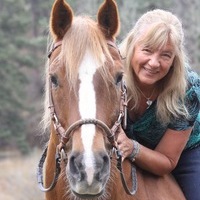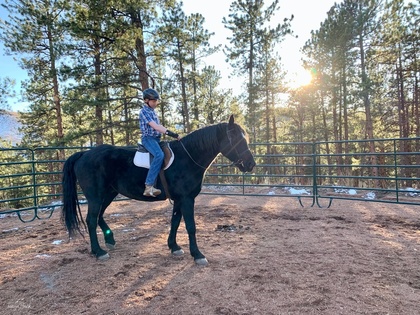
The Most Popular Horse Breeds Of 2019
Equestrian Advice & Guides General Equestrian
Build your business profile for FREE and expose your services to thousands of potential clients!
Create my profile now!
Do you think your horse is nuts in spring? Does he act up, act out, want to buck or run away with you? If so, let’s fix that here and now, shall we?
Here in Colorado, this past winter that includes the one we are so far having this spring, has made riding regularly rather difficult. And horses do seem to store energy like batteries—they spend all winter recharging, getting fed extra and working less. Spring comes and the snow melts, green grass shoots appear, birds chirp and dandelions bloom. It’s a glorious time of year for all, as long as you don’t mind the mud, the wind or the rain; and all because riding your horse is once again possible!
Years ago, I had a client who was convinced his horses stood around all winter planning on how they could act up with him when he rode each for the first time in the spring. He called this their “Spring Fling” and laughed it off, swearing he’d be thrown on the first ride of the year by each of his three horses, and then the rest of the summer would be great.
He expected to be thrown and seemed to view each landing as a rite of passage. He accepted it and laughed about the bruises he’d sport every spring after those first rides.
Some people, like my client, dread the first ride of the year for fear of getting dumped or being run away with, and may choose to hire a trainer to take the edge off, or tune the horse up for them before riding out themselves. This is not a bad plan, and if you don’t feel safe with your horse come spring and that first ride, do get a trainer to help you.
Another option is to go back to basics building the relationship, cues and progression of gearing up for work again after so much down time. This portion of preparation should be gradual, fun and safe for both you and your horse. Take him out to a safely fenced round pen, arena or pasture that has good footing and let him get rid of the ya-ya’s without you on him. Let him do this at liberty, alone or in the company of another horse and don’t try to control his speed or direction. In other words, let him play how he wants and for however long he chooses.
Remember that he is out of shape and be careful that he doesn’t overdo it; he’ll tire easier and you will need to monitor him for overexertion. With the winter coat he is most likely still sporting, check that he’s not overheated and sweating too much while he’s playing. Check his respiration rate, heart rate and overall appearance to be sure he is within his normal range and not too far above. If needed, end the session early.
Once he’s run, bucked and cartwheeled the willies away, halter him and ask him for some easy movements like moving his hip away or toward you, stepping over logs, backing an L, or moving his shoulder away from you. What you’re really doing is getting his attention on you and you are rewarding him for every correct answer he gives you. This helps to reestablish the fun relationship you had last summer and fall when you were riding regularly.
After you have reconnected by doing some exercises in-hand, you could either call it a day and give him a good grooming, or you could tack up and ride for fifteen minutes at a walk only, in an arena or round pen. The fifteen minute rule is crucial. Time yourself and no matter how good your ride is going, stop, praise and dismount. If your fifteen minutes of riding wasn’t stellar, so what? Quit and do the same routine the next day. What you are doing here, is reestablishing the relationship you had last fall, when you riding regularly.
The next day, you do exactly the same as you did today, and again, you ride, at a walk for 15 minutes exactly. Repeat this 15 minute routine for as many days as it takes for your horse, not you, to get back to being calm, obedient, compliant and happy. Then, you are both ready to go for a longer ride. You can choose to stay in the arena or do a short—yes, you guessed it, 15 minute—ride near the barn, or along a trail. Once you feel that you are both on the same page, extend the trail riding time and begin conditioning for longer and more strenuous rides.
Build your relationship, remind your horse what each cue means, and recondition both of your brains and bodies slowly.
A well-trained horse knows what to do and how to do it, so it won’t take long to be back where you left off last fall. A green horse may take a bit more time, but will still come around to understanding he is to remain calm when with you because he knows you are listening to his needs and that you’ll always keep him safe, while not asking too much of him.
As you get back into a routine, remember that horses love routines and hate them at the same time. This means they get bored, just as we do, but they also are fully capable of long periods of concentration IF they like the games you are playing with them. All training should be fun, engaging and encouraging, but first, we must create the relationship we want. To do this, build on keeping the horse safe and let him know you’ll never ask too much of him at any time. Once he views you as his safety person, anything is possible!
Springtime does not need to mean you will get bucked off, run away with, or have a horse that doesn’t listen. It does mean that you will want to spend time renewing your riding relationship if you’ve taken time off during the winter. It means he needs to be conditioned; sometimes before you get back on him in this new year. By taking care of his physical, mental and emotional needs, you’ll find your horse is happier to comply with your wishes and you can pick back up where you left off.
Happy spring, enjoy your rides, Happily Ever After!
~Tanya Buck
Free stuff as always—Here’s another bookmark. Trim as needed, or use as an art piece! (I find this one quite fitting for this article; what’s better than a bucking bronco, right?) Get it here:
https://lp.constantcontactpages.com/su/JKogpzp/springflingbuckinbookmark

